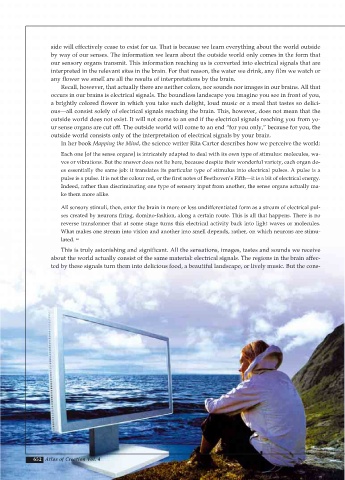Page 654 - Atlas of Creation Volume 4
P. 654
side will effectively cease to exist for us. That is because we learn everything about the world outside
by way of our senses. The information we learn about the outside world only comes in the form that
our sensory organs transmit. This information reaching us is converted into electrical signals that are
interpreted in the relevant sites in the brain. For that reason, the water we drink, any film we watch or
any flower we smell are all the results of interpretations by the brain.
Recall, however, that actually there are neither colors, nor sounds nor images in our brains. All that
occurs in our brains is electrical signals. The boundless landscape you imagine you see in front of you,
a brightly colored flower in which you take such delight, loud music or a meal that tastes so delici-
ous—all consist solely of electrical signals reaching the brain. This, however, does not mean that the
outside world does not exist. It will not come to an end if the electrical signals reaching you from yo-
ur sense organs are cut off. The outside world will come to an end “for you only,” because for you, the
outside world consists only of the interpretation of electrical signals by your brain.
In her book Mapping the Mind, the science writer Rita Carter describes how we perceive the world:
Each one [of the sense organs] is intricately adapted to deal with its own type of stimulus: molecules, wa-
ves or vibrations. But the answer does not lie here, because despite their wonderful variety, each organ do-
es essentially the same job: it translates its particular type of stimulus into electrical pulses. A pulse is a
pulse is a pulse. It is not the colour red, or the first notes of Beethoven’s Fifth—it is a bit of electrical energy.
Indeed, rather than discriminating one type of sensory input from another, the sense organs actually ma-
ke them more alike.
All sensory stimuli, then, enter the brain in more or less undifferentiated form as a stream of electrical pul-
ses created by neurons firing, domino-fashion, along a certain route. This is all that happens. There is no
reverse transformer that at some stage turns this electrical activity back into light waves or molecules.
What makes one stream into vision and another into smell depends, rather, on which neurons are stimu-
lated. 44
This is truly astonishing and significant. All the sensations, images, tastes and sounds we receive
about the world actually consist of the same material: electrical signals. The regions in the brain affec-
ted by these signals turn them into delicious food, a beautiful landscape, or lively music. But the cons-
652 Atlas of Creation Vol. 4

